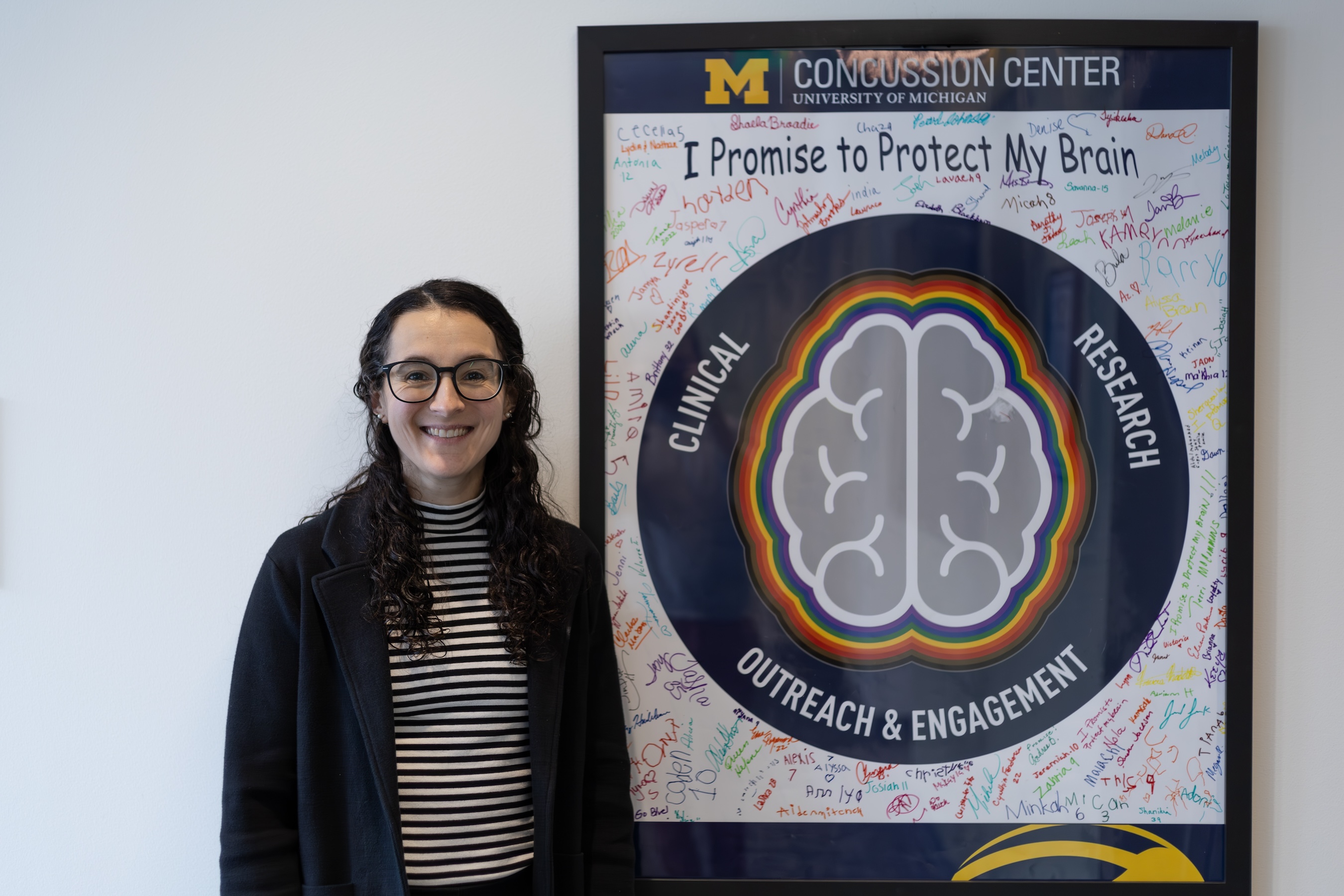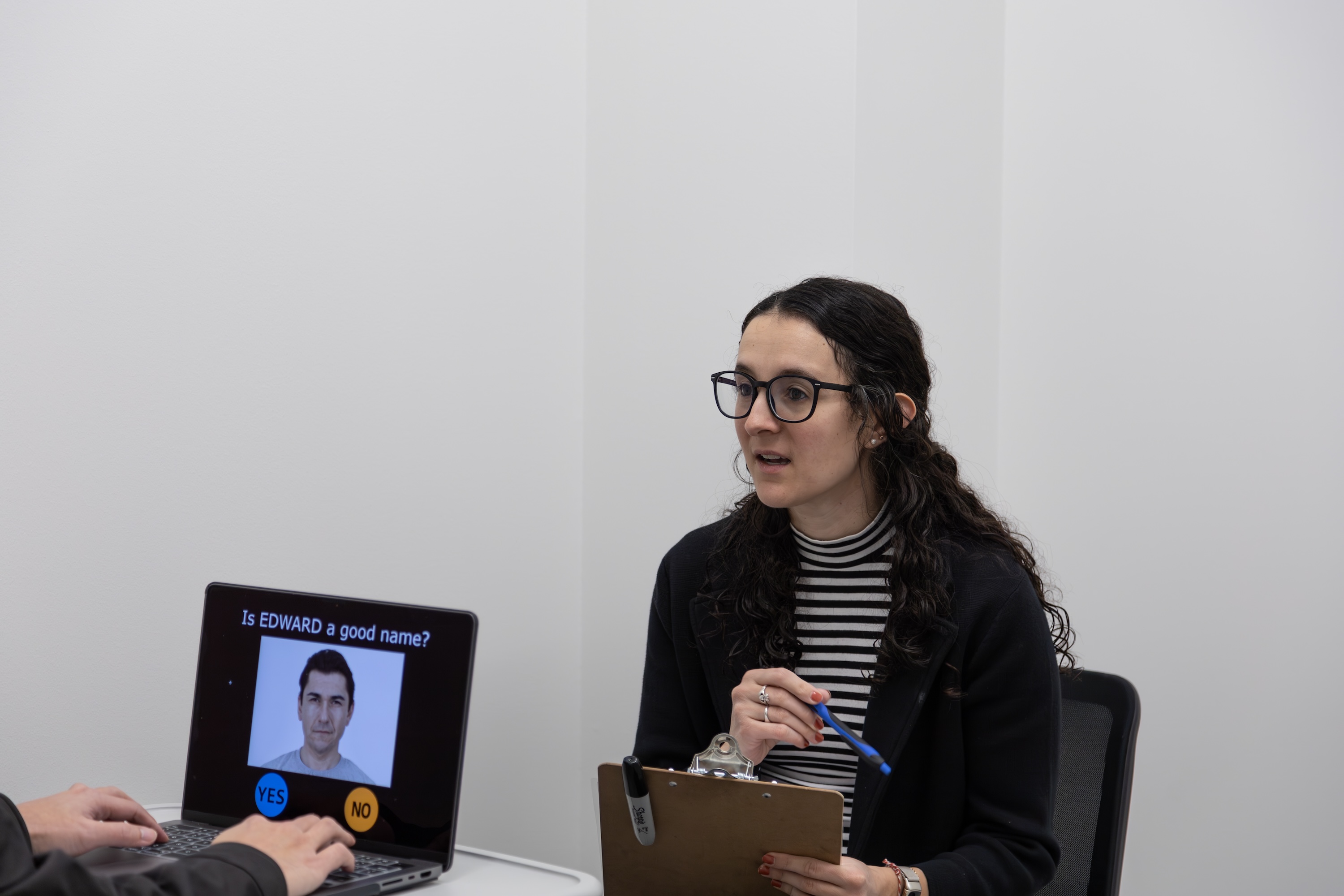
 Back to News
Inside the Research
Back to News
Inside the Research
What is it like to start your first lab?

It was Eleanna Varangis’ dream to helm a lab of her own — and in 2019, she seemed on the cusp of making it happen.
A faculty position had opened up to join the new University of Michigan Concussion Center, located at the School of Kinesiology. The center aimed to bring together a group of cross-campus experts pursuing novel solutions that advanced concussion knowledge and protocols.
Varangis, a long-time football fan, had studied the brain structure and function of NFL and college athletes in graduate school. During her post-doctoral research, she had focused on why certain people stay cognitively healthy for longer in older age, with hopes of one day exploring those same questions in aging former athletes. The U-M job seemed like an ideal fit to pursue that work.
But then, the COVID-19 pandemic struck. U-M issued a hiring freeze for faculty positions.
“That was a stressful situation to be in for everyone,” Varangis says, “because we didn’t know what to expect or how to plan for anything.”
By the time U-M offered Varangis the position of movement science assistant professor in 2022, three years had passed since she’d applied to the role. She’d written more than a dozen papers on the neural basis of aging (as part of her postdoc position at Columbia University, which her supervisor had kindly extended), and given birth to two children.
“Being able to actually walk into my office knowing that I was a professor,” Varangis says, “that was a little surreal.”
Starting her Assessing Traumatic Head Injury with Neurocognitive Approaches (ATHINA) Lab at SoK was, in some ways, far less stressful than waiting to see if she’d secure her first faculty gig. But she still felt plenty of uncertainty about whether she’d fit into SoK as a cognitive neuroscientist and how to navigate the logistics of opening her first lab at such a large university.
“The thing I’ve learned most is that it’s really hard to prepare for these kinds of transitions,” Varangis says. “I think the best thing you can do is find people who can help you navigate the new environment really well.”

'Michigan has every single thing you could ever want’
Varangis had studied cognitive psychology and neuroscience during her master’s and PhD studies at the University of North Carolina Chapel Hill and worked in the neurology department at Columbia University for her postdoctoral research. Her research bridges psychology and sports science, so it didn’t take a cognitive leap to understand why she’d ended up in the kinesiology space. And it seemed like she’d get along with her SoK colleagues at U-M.
But Varangis worried that her lab might be out of place in the environment. Her studies required MRI machines and probed the brains of those who played sports, while she assumed her colleagues were more likely monitoring physical activity.
She expected to feel some tension — but to her surprise, she found none. The Concussion Center offices are right next to the neuroscience research suite in the building, and there’s an MRI machine nearby. U-M’s East Hall, which houses the university’s psychology department, is an eight-minute walk away. When Varangis reached out to the Cognition and Cognitive Neuroscience faculty in her first days on the job, the team welcomed her to their weekly lab meeting.
“I thought I might face pushback because my efforts are so interdisciplinary,” Varangis says. “But being close to faculty who know the realities of concussion and having a close connection with experts who know the best ways to understand the brain gives me the best of both worlds.”
And everyone was generous with their time and expertise. Steve Broglio, the director of the U-M Concussion Center, offered himself as a resource to point Varangis in the right direction for whatever she needed, and her other colleagues were thinking about her research so much that they emailed her after hours about ideas. As she figured out the new-to-her computing system on which she’d need to run calculations, prepared for her role as statistics instructor, and began the hiring process for her first lab manager, she asked for help many times.
“It’s true what you hear about this place,” she says. “Michigan has every single thing you could ever want; you just need to know where to look and what to ask.”

Studying the everyday athlete
In an ironic way, the delays in Varangis’ hiring had given her more time to think about how she would set everything up once she finally arrived at U-M. She figured out details like when she would hire a lab manager and when she would bring on a graduate student or a post-doc.
“Having a general timeline for all these processes helped me prioritize things better once I had boots on the ground in Ann Arbor,” Varangis says.
Hiring her lab manager, Michaela Broadnax, ended up being one of her best decisions. Broadnax had spent a couple of years as a clinical research coordinator at Case Western Reserve University, and her experience allowed her to handle all the paperwork required to get the lab going as Varangis juggled multiple roles. Broadnax even developed the central task for their first study.
This pilot work, which will build into the ATHINA lab’s first full study this year, is a response to the lack of research where concussions are most widespread: in amateur athletes, like those playing sports in high school or recreational leagues. So far, few have asked what has happened to the brains of these athletes over their lifetimes — and more critically, why some of their brains stay sharper for longer.
“Most concussion studies focus on professional athletes,” Varangis says. “We want to look at the everyday athlete and study them long after they’re athletes or have suffered concussions.”
As a teenager, Varangis watched college football with her grandfather, a giant Notre Dame fan. Although he taught her to love the sport, she recognized how much both heartbreak and mystery were intertwined in the game, given the injuries the players endured.
Now, she’ll try to solve some of those mysteries by asking former athletes to lay in an MRI scanner and recall a simple “two-item” memory, like a name with a face. The functional MRI scan can indirectly measure brain activity associated with that effort. Varangis’ mentor in graduate school at UNC-Chapel Hill, Kelly Giovanello, likened such tasks in the MRI to the cardiac-stress tests of the EKG. Exercise reveals a heart’s subtle differences; cognitive effort reveals a brain’s.
“People may report things like memory concerns as they age,” Varangis says. “We know that this is something that's affected in both healthy aging as well as in concussion. So this would be a good way to look at what the brain is doing when people are doing something that they might consider challenging, regardless of whether or not they have sustained any concussions.”
Another asset in moving Varangis’ research forward has been the Marie Hartwig Pilot Research Fund, an internal grant at SoK that often supports early-career researchers. The $40,000 award has helped Varangis with her pilot work as well as the recruiting and design for her upcoming study.
“The grant came at a perfect time because we were just starting to put all the pieces of my research together,” Varangis says. “It meant a lot to receive that funding.”
Varangis has recently hired a postdoctoral researcher and three undergraduate assistants to help her and is eager for her first full study to begin
“I feel very happy to be building a lab that I’m confident in,” she says, “and I’m really excited about where we’re going.”
Want more advice about how to start a lab? Varangis and crew give their best tips for success.
Eleanna Varangis, a lab director
- Try not to compare yourself to others. “There are so many opportunities to compare yourself to other people, to see someone who are doing these mind-blowing things, and to think, ‘I should be doing that, too; I need to be doing that, too’ to catch up to the tenure clock. But any comparisons to other people are inevitably going to result in you being disappointed or thinking of yourself as less than you actually are. Be gentle with yourself; you'll find your footing.”
- Don’t be afraid to ask for help. "Don't sit there struggling for too long. There are so many people who are happy to help and willing to give their time and expertise that it's not worth wasting your time banging your head against a wall.”
Michaela Broadnax, a lab manager
- Understand that it might take some time to adjust to the rules of a new institution. “Research across the globe can be different; the departments run differently, and procedures for getting a research study are often completely different. Because you’re both new, you’re both learning. So be patient with each other as you’re navigating and figuring it out.”
- Keep communication open. “Have conversations early on where you figure out what each other likes and doesn’t like. And don’t be afraid to speak up and share as much new information as you can. There is a difference in roles between the PI and the lab manager, so you’re getting different training. But the more you both know, the better.”
Steve Broglio, a senior colleague
- Be proactive. “We as senior faculty have an obligation to go to the person we’re working with and check in and ask about projects and make sure they have access to the resources that we’re aware of. They don’t know what they don’t know. There’s some responsibility on us to help them through that.”